Unit 3 Could you please tell me where the restrooms are知识点讲解课件(共66张PPT)
文档属性
| 名称 | Unit 3 Could you please tell me where the restrooms are知识点讲解课件(共66张PPT) |  | |
| 格式 | pptx | ||
| 文件大小 | 519.6KB | ||
| 资源类型 | 教案 | ||
| 版本资源 | 人教新目标(Go for it)版 | ||
| 科目 | 英语 | ||
| 更新时间 | 2024-07-03 22:28:36 | ||
图片预览


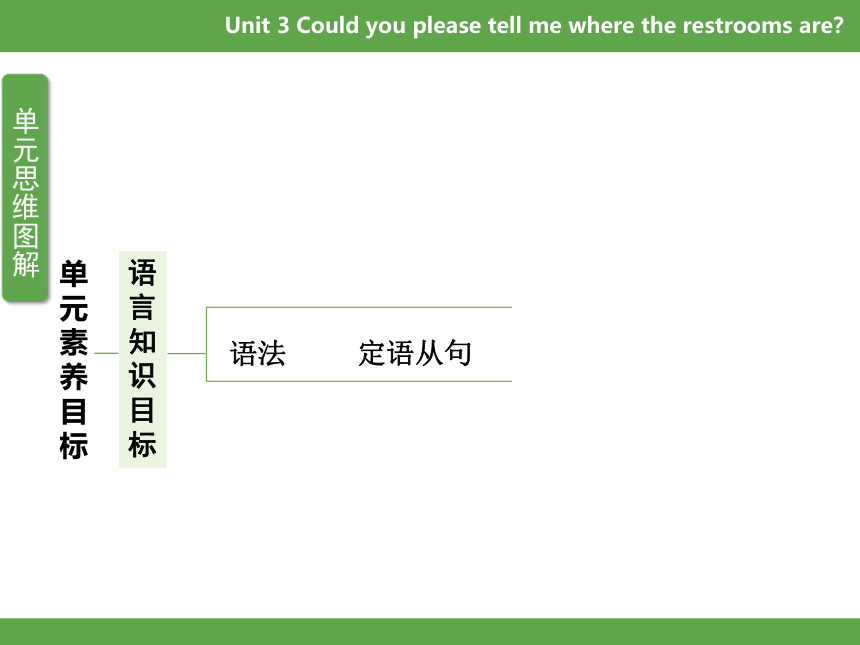
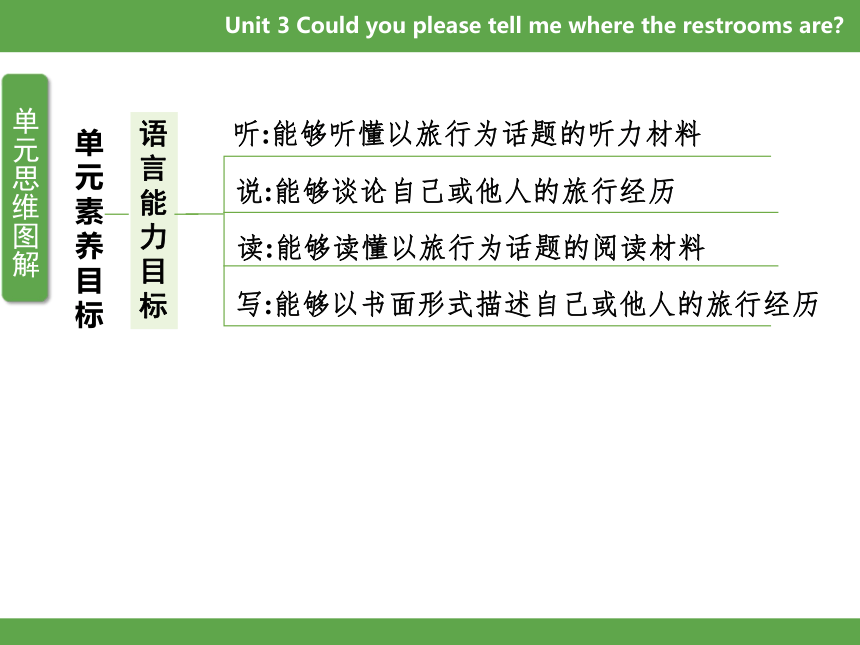
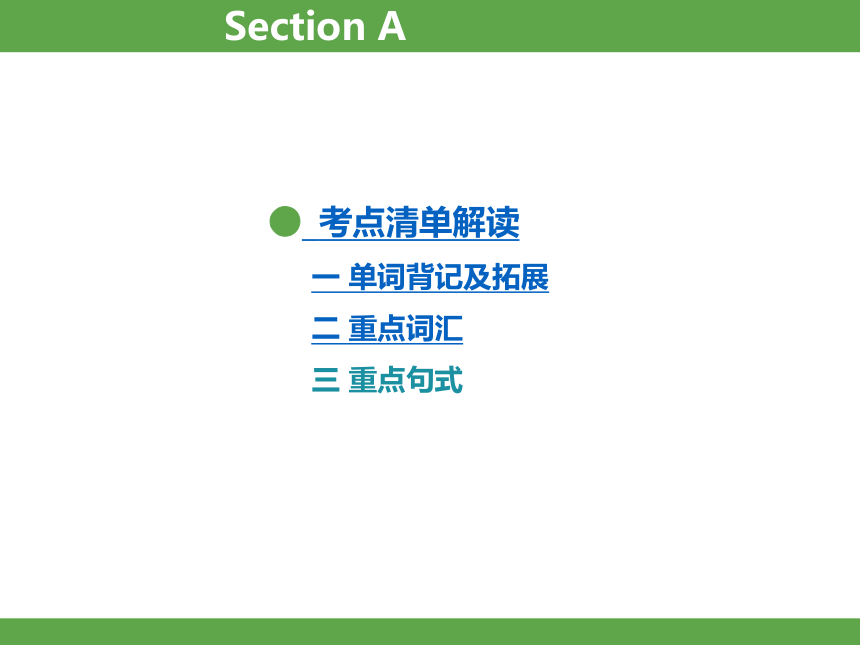
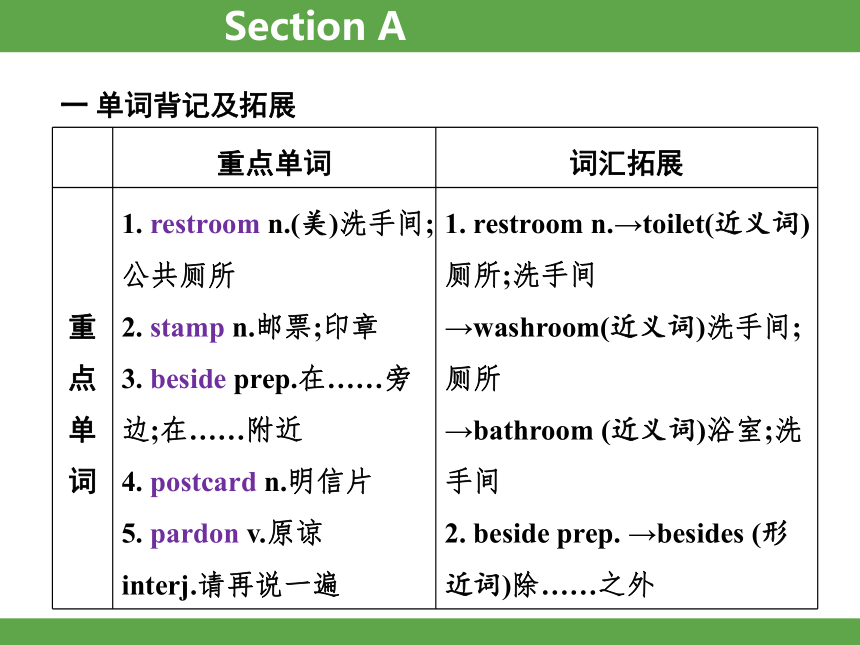
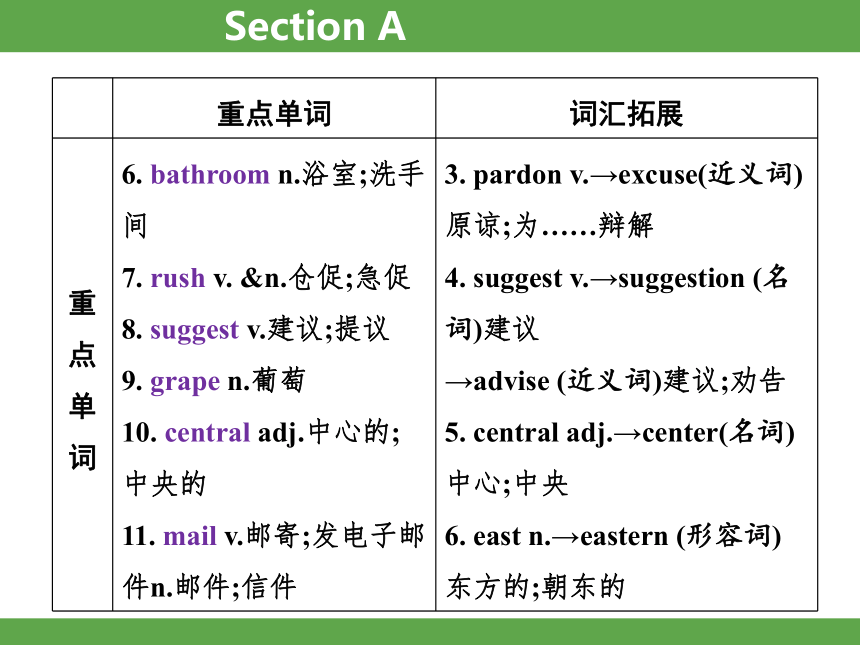
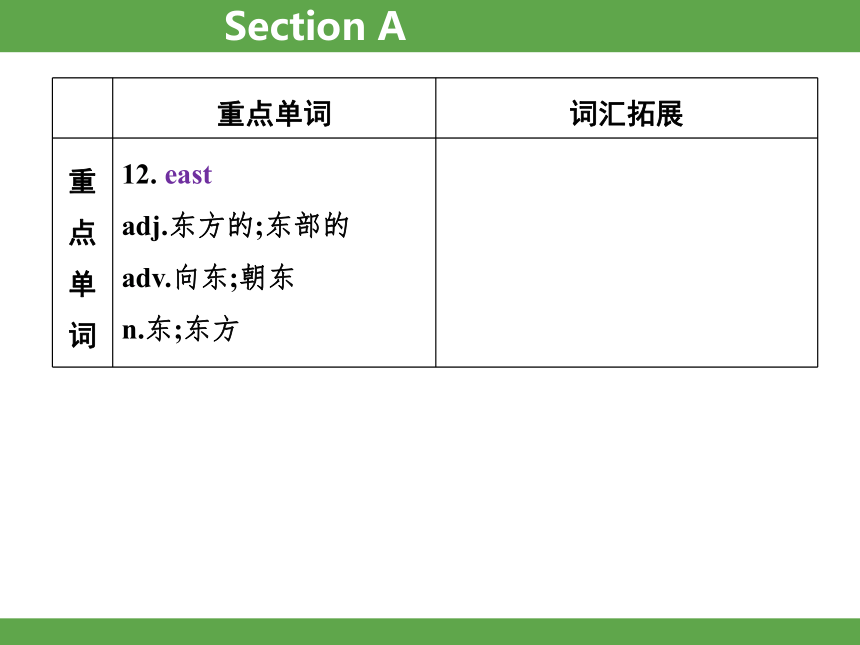
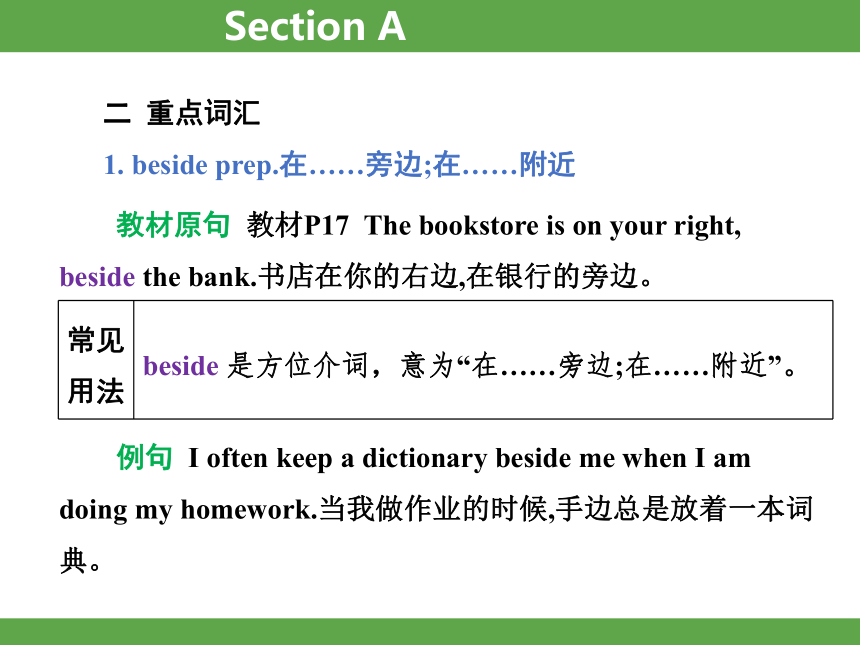

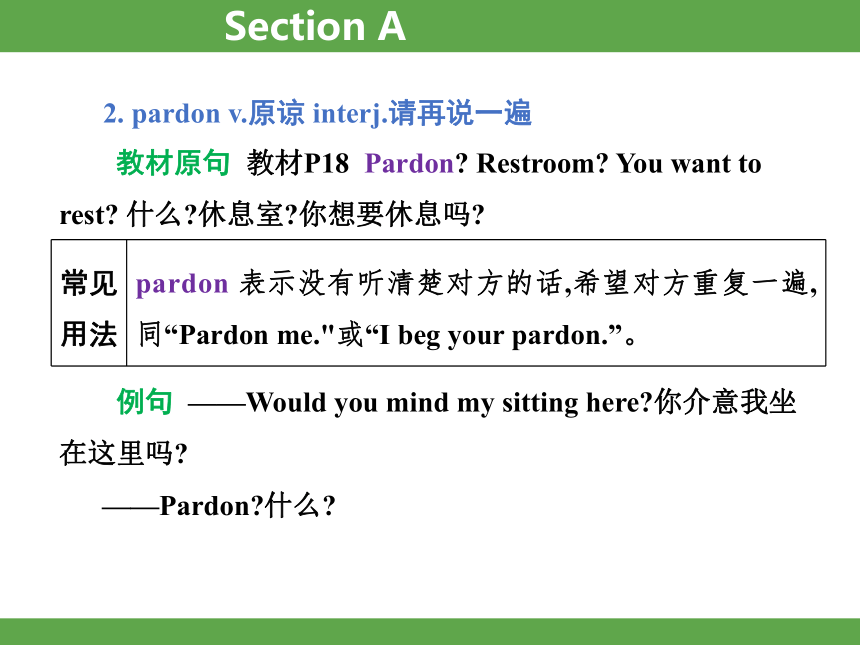
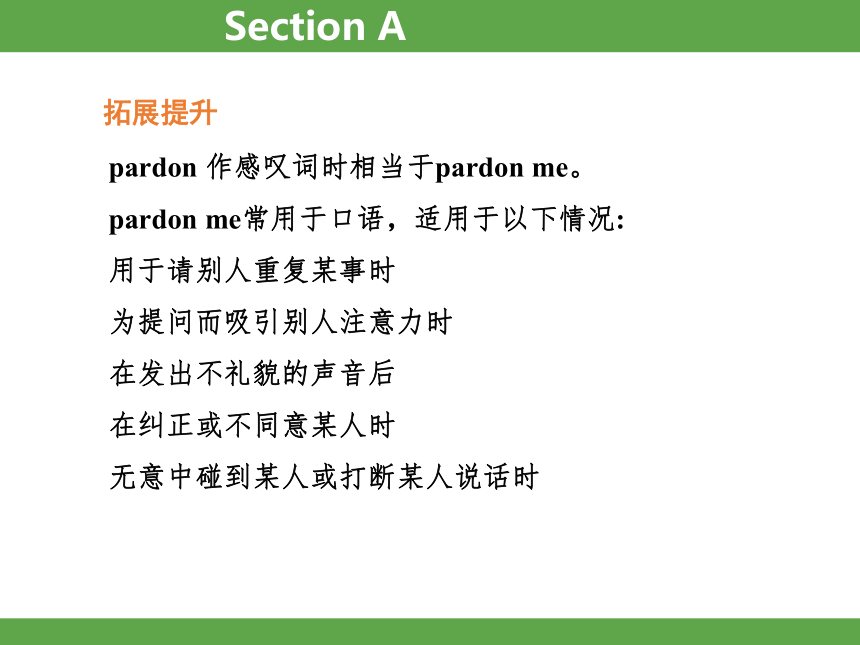
文档简介
(共66张PPT)
Unit 3 Could you please tell me where the restrooms are?
语
言
知识目
标
单元素养目标
词汇
话题
游览(Getting around )
四会词
restroom; stamp; beside; postcard; pardon; bathroom; rush;suggest; grape; central; mail; east; convenient; corner; politely;request; direction; correct; polite; direct; speaker; whom;impolite; address; underground; course
非四会词
bookstore; washroom; normally; staff; nearby; fascinating;inexpensive; uncrowded; mall; clerk; Italian
Unit 3 Could you please tell me where the restrooms are?
语
言
知识目
标
单元素养目标
重点句型
重点短语
on one's right; between... and...;
turn left/ right; pardon me;
on one's way to; pass by;
communicate with...
1. Excuse me, could you please tell me how to get to the bookstore
2. Sure, just go along Main Street until you pass Center Street.
3. Do you know when the bookstore closes today
4. Before we decide, could you first tell me where the restrooms are
5. Both are correct, but the first one sounds less polite.
6. Sometimes we even need to spend time leading into a request.
Unit 3 Could you please tell me where the restrooms are?
语
言
知识目
标
单元素养目标
语法
定语从句
语言能力目标
单元素养目标
听:能够听懂以旅行为话题的听力材料
说:能够谈论自己或他人的旅行经历
读:能够读懂以旅行为话题的阅读材料
写:能够以书面形式描述自己或他人的旅行经历
Unit 3 Could you please tell me where the restrooms are?
● 考点清单解读
一 单词背记及拓展
二 重点词汇
三 重点句式
Section A
Section A
一 单词背记及拓展
重点单词 词汇拓展
重 点 单 词 1. restroom n.(美)洗手间;公共厕所 2. stamp n.邮票;印章 3. beside prep.在……旁边;在……附近 4. postcard n.明信片 5. pardon v.原谅 interj.请再说一遍 1. restroom n.→toilet(近义词)厕所;洗手间
→washroom(近义词)洗手间;厕所
→bathroom (近义词)浴室;洗手间
2. beside prep. →besides (形近词)除……之外
Section A
重点单词 词汇拓展
重 点 单 词 6. bathroom n.浴室;洗手间 7. rush v. &n.仓促;急促 8. suggest v.建议;提议 9. grape n.葡萄 10. central adj.中心的;中央的 11. mail v.邮寄;发电子邮件n.邮件;信件 3. pardon v.→excuse(近义词)原谅;为……辩解
4. suggest v.→suggestion (名词)建议
→advise (近义词)建议;劝告
5. central adj.→center(名词)中心;中央
6. east n.→eastern (形容词)东方的;朝东的
Section A
重点单词 词汇拓展
重 点 单 词 12. east adj.东方的;东部的 adv.向东;朝东 n.东;东方
Section A
二 重点词汇
1. beside prep.在……旁边;在……附近
教材原句 教材P17 The bookstore is on your right, beside the bank.书店在你的右边,在银行的旁边。
例句 I often keep a dictionary beside me when I am doing my homework.当我做作业的时候,手边总是放着一本词典。
常见用法 beside 是方位介词,意为“在……旁边;在……附近”。
Section A
易混辨析
易混词 词性 含义及用法
beside 介词 意为“在……旁边;在……附近”,表示位置关系。
besides 介词 意为“除……之外(还)”。
副词 意为“而且”。
beside 与 besides的用法区别
Section A
2. pardon v.原谅 interj.请再说一遍
教材原句 教材P18 Pardon Restroom You want to rest 什么 休息室 你想要休息吗
例句 ——Would you mind my sitting here 你介意我坐在这里吗
——Pardon 什么
常见用法 pardon 表示没有听清楚对方的话,希望对方重复一遍,同“Pardon me."或“I beg your pardon.”。
Section A
拓展提升
pardon 作感叹词时相当于pardon me。
pardon me常用于口语,适用于以下情况:
用于请别人重复某事时
为提问而吸引别人注意力时
在发出不礼貌的声音后
在纠正或不同意某人时
无意中碰到某人或打断某人说话时
Section A
3. go past 经过;路过
教材原句 教材P18 Go past the bookstore.经过书店。
常见用法 go past 意为“经过;路过”,相当于pass 或pass by。其中past 用作介词,意为“在另一边,到另一侧”。past还有其他用法:作介词,意为“在……之后;晚于”;作副词,意为“经过;从一侧到另一侧”;作形容词,意为“过去的”。
Section A
例句 Go past a garden and you can see my house on the left.经过一个花园,你就会看到我的房子在左边。
It's five past seven now.现在是7:05。
I called out to him as he ran past.他跑过时,我大声喊他。
Jenny has put on three pounds in the past 2 months.近两个月,珍妮体重增加了3磅。
Section A
图解妙记
Section A
4. suggest v.建议;提议
教材原句 教材P19 I suggest Water City Restaurant in Water World.我建议去水世界的水上城市餐厅。
Section A
常见用法
suggest 作动词,意为“建议;提议”,有如下用法:
用法 例句
suggest sth.建议某事 I suggest Plan B.我建议采用B计划。
suggest doing sth.建 议做某事 My father suggested going out for a walk.我的爸爸建议出去散步。
suggest+that引导的 宾语从句,建议…… He suggested that we (should) come here soon.他建议我们尽快来这里。
Section A
拓展应用
suggest的名词形式是suggestion(可数名词),意为“建议;提议”。如:In my opinion, his suggestion is the best of all. 我认为他的建议是最好的。
易错提示
表示“建议某人做某事”不能用suggest sb. to do sth.,可用advise sb. to do sth.
Section A
5. pass by 路过;经过
教材原句 教材P19 On their way to Water City Restaurant, Alice and He Wei pass by Uncle Bob's.在他们去水上城市餐厅的路上,爱丽丝与何伟路过鲍勃叔叔的餐厅。
常见用法 pass by 意为“路过;经过”,其后可接名词(短语)或代词,此时by作介词;其后也可不接成分,此时by作副词。
例句 I see the boy pass by my house every day.我每天都看见那个男孩经过我家。
Section A
拓展提升
含有 pass 的其他常见短语:
pass away 去世
pass on 传给
pass sb. sth.=pass sth. to sb.向某人传递某物
Section A
三 重点句式
1. until 引导的时间状语从句
教材原句 教材P17 Sure, just go along Main Street until you pass Center Street.当然可以,沿着主街走,直到你穿过中央大街。
常见用法 until 是连词,意为“直到……为止”,引导时间状语从句。not...until... 意为“直到……才……”,引导时间状语从句。
例句 Go straight along the road until you see a post office.沿着这条路直走,直到你看见一个邮局。
Section A
易混辨析 until 与 not... until...的用法区别
易混词(组) 用法
until 句子或主句的谓语动词必须是延续性动词,表示这一动作或状态一直延续到until所表示的时间为止。延续性动词有live,wait,work 等。
not... until... 句子或主句的谓语动词一般是非延续性动词,表示这一动作或状态从 until 所表示的时间开始发生。非延续性动词有leave, go,realize, reach, arrive 等。
Section A
2. 陈述句形式的问句
教材原句 教材P18 You want to rest 你想要休息吗
常见用法 此句是一种一般疑问句的口语表达方式,即以陈述句形式靠结尾用问号和突出升调来表示疑问,常含有惊讶、怀疑或奇怪等语气。其正常语序为“Do you want to rest ”。
例句 He ended up as a doctor 他最后当医生了
易错提示
在书面表达中,一般不采用这样的结构。
Section A
3. come on 的用法
教材原句 教材P19 Come on!勇敢些!
常见用法 come on 通常有以下含义和用法:
(1)意为“来吧;干吧”,用来表示请求、劝说等。
(2)意为“赶快;快点儿”,表示“催促”。
(3)意为“加油”,用于体育竞赛等场合鼓励运动员。
(4)意为“来吧;来呀”,用于挑战或激怒对方。
(5)意为“算了吧;得了吧”,表示责备或不耐烦。
Section A
例句 Come on, Kate. Don't be shy.来吧,凯特。别害羞。
Come on! It’s late.快点!晚了。
Come on, don't lie.得了吧,别撒谎了。
Section A
拓展提升
与 come 相关的其他常见动词短语:
come out(太阳等)出来;出版;公开
come up with 想出;提出
come over 过来;顺便拜访
come from 来自
come true 实现
Section A
4.助动词 do 表强调
教材原句 教材P19 I was scared at first, but shouting did help.起初我很害怕,但大声喊确实很管用。
常见用法 助动词do 放在谓语动词前起强调作用,用来表达说话者的一种强烈的感情。do要重读,意为“确实;一定;务必;的确”等,后接动词原形。do随主语的人称、数和句子时态的变化而变化,但只有三种形式,即do,does和did。
例句 The teacher did warn us about the danger.老师的确警告过我们注意危险。
Section A
拓展提升
助动词do 的其他用法:
(1)构成否定。如:don't like
(2)构成疑问句。如:Do you like coffee
Section A
5. a little 修饰比较级的用法;动词不定式表目的的用法
教材原句 教材P19 The restaurant is always busy at that time, so come a little earlier to get a table.那时餐厅人总是很多,所以得来早一些。
常见用法 (1)a little 意为“一点”,修饰副词的比较级earlier。
(2)句中的to get a table是不定式短语作目的状语。动词不定式作目的状语通常放在句子后面,如果放在前面,应用逗号隔开。
Section A
例句 You'd better get up a little earlier to catch the first bus.为了赶上首班公交车,你最好早点起床。
She studied hard to pass the exam.她努力学习,为了能通过考试。
Section A
拓展提升
even, a bit, a lot,much等也可以修饰比较级。如:This car is much more expensive than that one.这辆小汽车比那辆贵多了。
易错提示
动词不定式作目的状语前置时,起强调作用,后用逗号隔开。
● 考点清单解读
一 单词背记及拓展
二 重点词汇
三 重点句式
四 重点语法
Section B
Section B
一 单词背记及拓展
重点单词 词汇拓展
重 点 单 词 1. convenient adj.便利的;方便的 2. corner n.拐角;角落 3. politely adv.礼貌地;客气地 4. request n. & v.要求;请求 5. direction n.方向;方位 1. politely adv. →polite(形容词)有礼貌的;客气的
2. correct adj.→correctly(副词)正确地;恰当地
→incorrect(反义词)错误的;不正确的
3. direct adj. →indirect (反义词)间接的;迂回的
Section B
重点单词 词汇拓展
重 点 单 词 6. correct adj.正确的;恰当的 7. polite adj.有礼貌的;客气的 8. direct adj.直接的;直率的 9. speaker n.讲(某种语言)的人;发言者 →directly (副词)直接地;立即;马上
4. speaker n.→speak(动词)说话;演讲;表明;陈述
5. whom pron. →who (代词)谁;什么人
6. impolite adj.→polite(反义词)有礼貌的;客气的
Section B
重点单词 词汇拓展
重 点 单 词 10. whom pron. 谁;什么人 11. impolite adj.不礼貌的;粗鲁的 12. address n.住址;地址;通信处 13. underground adj.地下的n.地铁 14. course n.课程;学科 →impolitely(副词)不客气地;无礼地
7. underground n.→subway(近义词)地铁
熟词生义
address 作名词,还可意为“演讲”;作动词,还可意为“写(收信人)姓名、地址”。
Section B
二 重点词汇
1. convenient adj.便利的;方便的
例句 It’s convenient for me to go to the mall nearby.对我来说去附近的购物中心是很方便的。
常见用法 convenient 为形容词,意为“便利的;方便的”,其主语不能是人。常用于下列结构:It's convenient for sb. to do sth.对某人来说做某事是方便的。
Section B
拓展提升
convenience 为名词,意为“方便,便利;便利的设施”。如:
The house has all the modern conveniences.这所房子里有所有现代化的便利设施。
Section B
2. ask (sb.) about sth.询问(某人)关于某事的情况;tell sb. todo sth.告诉某人做某事
教材原句 教材P21 The girl asks about public restrooms, and the clerk tells her to go to the corner of Market and Middle Streets.
这个女孩询问是否有公共厕所,职员告诉她去市场大街和中心大街交叉的拐角处。
常见用法 (1)ask (sb.) about sth.询问(某人)关于某事的情况。
(2)tell sb. to do sth.告诉某人做某事。其否定结构是tell sb. not to do sth.,意为“告诉某人不要做某事”。
Section B
例句 Tina asked (me) about the tradition of ChineseSpring Festival.蒂娜询问了我有关中国春节的传统。
My father told me not to rush.我爸爸告诉我不要着急。
Section B
3. polite adj.有礼貌的;客气的
教材原句 教材P22 We also need to learn how to be polite when we ask for help.当我们寻求帮助时,我们还需要学会礼貌。
常见用法 polite 为形容词,意为“有礼貌的;客气的”。
例句 It's polite to say thanks to others.对别人说谢谢是很有礼貌的。
Section B
拓展提升
短语:be polite to sb.对某人有礼貌
派生词:
politely adv.礼貌地
impolite adj.不礼貌的
impolitely adv.无礼地
Section B
4.request n. & v.要求;请求
教材原句 教材P22 These are similar requests for directions.这些是关于问路的类似请求。
Section B
常见用法
request 作名词时,意为“要求;请求”;作动词时,意为“要求;请求”,用法如下:
用法 例句
request sth. (from sb.)(向 某人)请求某事/某物 The poor man requested some water.这个可怜的人要些水喝。
Section B
request sb. to do sth.请求/ 要求某人做某事 My father requests me to do my homework by myself.我爸爸要求我独立完成作业。
request +that从句请求/要求…… I request that we (should) finish the task on time.我要求我们按时完成任务。
Section B
拓展提升
request 作名词时的固定搭配:
如:I bought it at your request.我应你的要求买下来。
Section B
5. spend... doing sth.花费……做某事
教材原句 教材P22 Sometimes we even need to spend time leading into a request.有时我们甚至需要花些时间来导入一个请求。
常见用法 spend time (in) doing sth.意为“花费时间做某事”。spend 还可以表示“花钱”,常用搭配:spend some money (in) doing sth./ on sth.花费钱做某事/在某物上。
Section B
看图背例句
My sister spends three hours (in) doing her report.我姐姐用了三个小时完成她的报告。
I spent 4,000 yuan on this new computer.
我花了4000元买这台新电脑。
Section B
易混辨析 spend, cost, take与 pay 的用法区别
(1)spend 主语是人,①spend some time/ money (in) doing sth.花费多少时间/钱做某事;
②spend some time/ money on sth.在某事/某物上花费多少时间/钱。
(2)cost 主语是物,sth.cost(s)(sb.) some money某物花费(某人)多少钱。
(3)take 常用it 作形式主语,It takes/ took sb. some time to do sth.做某事花费某人多少时间。
(4)pay 主语是人,sb.pay (s) some money for sth.某人为某物花费多少钱。
Section B
三 重点句式
1. less 构成的表示否定意义的比较级
教材原句 教材P22 Both are correct, but the first one sounds less polite.两种说法都正确,但是第一种听起来没那么有礼貌。
Section B
常见用法 本句中的less polite是表示否定意义的比较级,less可以和多音节、部分双音节形容词或副词一起构成表示否定意义的比较级。
例句 The black shirt is less expensive than the white one.这件黑色的衬衫比那件白色的要便宜。
Section B
易错提示
多音节和部分双音节形容词或副词的比较级和最高级有两种形式:
用法 意义
借助于 more,most 构成比较级和最高级 more... 表示“更……”
most... 表示“最……”
借助于 less,least 构成表示否定意义的比较级和最高级 less... 表示“不那么……;稍许不……”
least... 表示“最不……”
Section B
2. That is because...的用法
教材原句 教材P22 That is because it is a very direct question.那是因为它是一个非常直接的问题。
常见用法 “That is because...”意为“那是因为……”,because引导表语从句,强调某事发生的原因,该句式结构中的that还可以使用it或this 替换。
例句 Tom was late for work this morning. That is because he overslept.汤姆今天早晨上班迟到了。那是因为他睡过头了。
Section B
拓展提升
“That/ This/ It is why...”意为“那/这是……的 原因”,why 引导表语从句,表示结果。如:Tom overslept. That is why he was late for work this morning.汤姆睡过头了。那是他今天早晨上班迟到的原因。
Section B
四 重点语法
连接代/副词引导的宾语从句
教材原句 教材P20 Excuse me, do you know where I can buy some medicine 打扰一下,你知道我可以在哪里买药吗
教材P20 Could you tell us when the band starts playing this evening 你能告诉我们乐队什么时候开始演出吗
教材P20 I wonder where we should go next.我想知道接下来我们该去哪里。
Section B
易错提示
(1)宾语从句后的标点要根据主句的句子类型来确定。当主句是陈述句时,句末通常用句点;当主句是疑问句时,句末通常用问号。
(2)当who, which 对宾语从句的主语提问时,宾语从句的语序不变。如:Do you know who will give a speech 你知道谁将进行演讲吗
Section B
常见用法 宾语从句的引导词有三类,在Unit2中讲述了引导词that 和 if/ whether的用法。本单元的核心语法是“连接代/副词引导的宾语从句”。
1.连接代词引导的宾语从句
常见的连接代词有what, who, whom, whose,which等,它们在宾语从句中可以作主语、宾语、表语和定语等。
例句 Do you know who will come this afternoon 你知道今天下午谁会来吗
I don't know whose hat this is.我不知道这顶帽子是谁的。
Section B
2.连接副词引导的宾语从句
常见的连接副词有when, where, how, why等,它们在宾语从句中作状语。
例句 We didn't know when she would come back.我们不知道她什么时候回来。
Do you know where Mary is going 你知道玛丽打算去哪里吗
Section B
3.宾语从句的语序
在含有宾语从句的复合句中,宾语从句应使用陈述语序。
例句 Could you tell me when the plane will leave 你能告诉我飞机什么时间起飞吗
I wonder where she is from.我想知道她来自哪里。
I don't know how he did it.我不知道他是如何做到的。
Section B
4.宾语从句的时态
(1)主句如果是一般现在时或一般将来时,从句根据实际情况选用时态。
例句 I wonder whom that letter was from.我想知道是谁来的信。
(2)如果主句是一般过去时,从句要用相应的过去的某个时态。
Section B
例句 He said that there wasn't time to go to the center of the city.他说没有时间去市中心了。
She told me she was writing a letter.她告诉我她正在写一封信。
(3)当主句是一般过去时,从句所说明的是事实、客观真理时,从句仍然用一般现在时。
例句 The teacher told us that light travels faster than sound.老师告诉我们光的传播速度比声音快。
Section B
拓展提升
当宾语从句是由连接代/副词引导时,有时可以转换成“连接代/副词+动词不定式”作宾语,从而把句子由一个主从复合句变为简单句。如:
I don't know what I should do next.=I don't know what to do next. 我不知道下一步做什么。
语篇考法精讲
图片理解题解题技巧
典例剖析
We talked with June Galloway about her book Get off on the Right Foot: Don't Let the Wrong Gesture(手势)Ruin Your Day.What other gestures can cause misunderstanding
June: Take the gesture for “come here”for example. In North America, people gesture with the palm (掌心)up. Well, in southern Europe, that gesture means“goodbye". And in many Asian countries,the palm-up gesture is thought rude. Instead, people there gesture with the palm down.
语篇考法精讲
[中考新考法·图片理解]
Which gesture should you use if you want to say‘goodbye”in southern Europe
语篇考法精讲
[解析]根据“Take the gesture for ‘come here’for example. In North America, people gesture with the palm up. Well, in southern Europe, that gesture means ‘goodbye’.”可知,掌心朝上在欧洲南部意味着“再见”,故选A。
[答案] A
语篇考法精讲
考法说明
图片理解题是近年来英语阅读理解题中比较新颖的设题方式,它将文章中的信息以图片的形式展现出来,四个选项是四幅图片而不是文字,主要考查以下角度:
1.根据文中细节描述,选择符合题干要求的图片。
2.结合生活常识、跨学科知识或想象力选择合适的图片。
3.选择能够总结归纳文中大意的图片。
语篇考法精讲
技巧点拨
1.快速阅读题干找出关键词;
2.快速浏览文章确定该细节在文中出处;
3.仔细阅读题干,并将四幅图片所呈现的内容与文中细节内容作对比,选出最符合文章细节内容的图片。
Unit 3 Could you please tell me where the restrooms are?
语
言
知识目
标
单元素养目标
词汇
话题
游览(Getting around )
四会词
restroom; stamp; beside; postcard; pardon; bathroom; rush;suggest; grape; central; mail; east; convenient; corner; politely;request; direction; correct; polite; direct; speaker; whom;impolite; address; underground; course
非四会词
bookstore; washroom; normally; staff; nearby; fascinating;inexpensive; uncrowded; mall; clerk; Italian
Unit 3 Could you please tell me where the restrooms are?
语
言
知识目
标
单元素养目标
重点句型
重点短语
on one's right; between... and...;
turn left/ right; pardon me;
on one's way to; pass by;
communicate with...
1. Excuse me, could you please tell me how to get to the bookstore
2. Sure, just go along Main Street until you pass Center Street.
3. Do you know when the bookstore closes today
4. Before we decide, could you first tell me where the restrooms are
5. Both are correct, but the first one sounds less polite.
6. Sometimes we even need to spend time leading into a request.
Unit 3 Could you please tell me where the restrooms are?
语
言
知识目
标
单元素养目标
语法
定语从句
语言能力目标
单元素养目标
听:能够听懂以旅行为话题的听力材料
说:能够谈论自己或他人的旅行经历
读:能够读懂以旅行为话题的阅读材料
写:能够以书面形式描述自己或他人的旅行经历
Unit 3 Could you please tell me where the restrooms are?
● 考点清单解读
一 单词背记及拓展
二 重点词汇
三 重点句式
Section A
Section A
一 单词背记及拓展
重点单词 词汇拓展
重 点 单 词 1. restroom n.(美)洗手间;公共厕所 2. stamp n.邮票;印章 3. beside prep.在……旁边;在……附近 4. postcard n.明信片 5. pardon v.原谅 interj.请再说一遍 1. restroom n.→toilet(近义词)厕所;洗手间
→washroom(近义词)洗手间;厕所
→bathroom (近义词)浴室;洗手间
2. beside prep. →besides (形近词)除……之外
Section A
重点单词 词汇拓展
重 点 单 词 6. bathroom n.浴室;洗手间 7. rush v. &n.仓促;急促 8. suggest v.建议;提议 9. grape n.葡萄 10. central adj.中心的;中央的 11. mail v.邮寄;发电子邮件n.邮件;信件 3. pardon v.→excuse(近义词)原谅;为……辩解
4. suggest v.→suggestion (名词)建议
→advise (近义词)建议;劝告
5. central adj.→center(名词)中心;中央
6. east n.→eastern (形容词)东方的;朝东的
Section A
重点单词 词汇拓展
重 点 单 词 12. east adj.东方的;东部的 adv.向东;朝东 n.东;东方
Section A
二 重点词汇
1. beside prep.在……旁边;在……附近
教材原句 教材P17 The bookstore is on your right, beside the bank.书店在你的右边,在银行的旁边。
例句 I often keep a dictionary beside me when I am doing my homework.当我做作业的时候,手边总是放着一本词典。
常见用法 beside 是方位介词,意为“在……旁边;在……附近”。
Section A
易混辨析
易混词 词性 含义及用法
beside 介词 意为“在……旁边;在……附近”,表示位置关系。
besides 介词 意为“除……之外(还)”。
副词 意为“而且”。
beside 与 besides的用法区别
Section A
2. pardon v.原谅 interj.请再说一遍
教材原句 教材P18 Pardon Restroom You want to rest 什么 休息室 你想要休息吗
例句 ——Would you mind my sitting here 你介意我坐在这里吗
——Pardon 什么
常见用法 pardon 表示没有听清楚对方的话,希望对方重复一遍,同“Pardon me."或“I beg your pardon.”。
Section A
拓展提升
pardon 作感叹词时相当于pardon me。
pardon me常用于口语,适用于以下情况:
用于请别人重复某事时
为提问而吸引别人注意力时
在发出不礼貌的声音后
在纠正或不同意某人时
无意中碰到某人或打断某人说话时
Section A
3. go past 经过;路过
教材原句 教材P18 Go past the bookstore.经过书店。
常见用法 go past 意为“经过;路过”,相当于pass 或pass by。其中past 用作介词,意为“在另一边,到另一侧”。past还有其他用法:作介词,意为“在……之后;晚于”;作副词,意为“经过;从一侧到另一侧”;作形容词,意为“过去的”。
Section A
例句 Go past a garden and you can see my house on the left.经过一个花园,你就会看到我的房子在左边。
It's five past seven now.现在是7:05。
I called out to him as he ran past.他跑过时,我大声喊他。
Jenny has put on three pounds in the past 2 months.近两个月,珍妮体重增加了3磅。
Section A
图解妙记
Section A
4. suggest v.建议;提议
教材原句 教材P19 I suggest Water City Restaurant in Water World.我建议去水世界的水上城市餐厅。
Section A
常见用法
suggest 作动词,意为“建议;提议”,有如下用法:
用法 例句
suggest sth.建议某事 I suggest Plan B.我建议采用B计划。
suggest doing sth.建 议做某事 My father suggested going out for a walk.我的爸爸建议出去散步。
suggest+that引导的 宾语从句,建议…… He suggested that we (should) come here soon.他建议我们尽快来这里。
Section A
拓展应用
suggest的名词形式是suggestion(可数名词),意为“建议;提议”。如:In my opinion, his suggestion is the best of all. 我认为他的建议是最好的。
易错提示
表示“建议某人做某事”不能用suggest sb. to do sth.,可用advise sb. to do sth.
Section A
5. pass by 路过;经过
教材原句 教材P19 On their way to Water City Restaurant, Alice and He Wei pass by Uncle Bob's.在他们去水上城市餐厅的路上,爱丽丝与何伟路过鲍勃叔叔的餐厅。
常见用法 pass by 意为“路过;经过”,其后可接名词(短语)或代词,此时by作介词;其后也可不接成分,此时by作副词。
例句 I see the boy pass by my house every day.我每天都看见那个男孩经过我家。
Section A
拓展提升
含有 pass 的其他常见短语:
pass away 去世
pass on 传给
pass sb. sth.=pass sth. to sb.向某人传递某物
Section A
三 重点句式
1. until 引导的时间状语从句
教材原句 教材P17 Sure, just go along Main Street until you pass Center Street.当然可以,沿着主街走,直到你穿过中央大街。
常见用法 until 是连词,意为“直到……为止”,引导时间状语从句。not...until... 意为“直到……才……”,引导时间状语从句。
例句 Go straight along the road until you see a post office.沿着这条路直走,直到你看见一个邮局。
Section A
易混辨析 until 与 not... until...的用法区别
易混词(组) 用法
until 句子或主句的谓语动词必须是延续性动词,表示这一动作或状态一直延续到until所表示的时间为止。延续性动词有live,wait,work 等。
not... until... 句子或主句的谓语动词一般是非延续性动词,表示这一动作或状态从 until 所表示的时间开始发生。非延续性动词有leave, go,realize, reach, arrive 等。
Section A
2. 陈述句形式的问句
教材原句 教材P18 You want to rest 你想要休息吗
常见用法 此句是一种一般疑问句的口语表达方式,即以陈述句形式靠结尾用问号和突出升调来表示疑问,常含有惊讶、怀疑或奇怪等语气。其正常语序为“Do you want to rest ”。
例句 He ended up as a doctor 他最后当医生了
易错提示
在书面表达中,一般不采用这样的结构。
Section A
3. come on 的用法
教材原句 教材P19 Come on!勇敢些!
常见用法 come on 通常有以下含义和用法:
(1)意为“来吧;干吧”,用来表示请求、劝说等。
(2)意为“赶快;快点儿”,表示“催促”。
(3)意为“加油”,用于体育竞赛等场合鼓励运动员。
(4)意为“来吧;来呀”,用于挑战或激怒对方。
(5)意为“算了吧;得了吧”,表示责备或不耐烦。
Section A
例句 Come on, Kate. Don't be shy.来吧,凯特。别害羞。
Come on! It’s late.快点!晚了。
Come on, don't lie.得了吧,别撒谎了。
Section A
拓展提升
与 come 相关的其他常见动词短语:
come out(太阳等)出来;出版;公开
come up with 想出;提出
come over 过来;顺便拜访
come from 来自
come true 实现
Section A
4.助动词 do 表强调
教材原句 教材P19 I was scared at first, but shouting did help.起初我很害怕,但大声喊确实很管用。
常见用法 助动词do 放在谓语动词前起强调作用,用来表达说话者的一种强烈的感情。do要重读,意为“确实;一定;务必;的确”等,后接动词原形。do随主语的人称、数和句子时态的变化而变化,但只有三种形式,即do,does和did。
例句 The teacher did warn us about the danger.老师的确警告过我们注意危险。
Section A
拓展提升
助动词do 的其他用法:
(1)构成否定。如:don't like
(2)构成疑问句。如:Do you like coffee
Section A
5. a little 修饰比较级的用法;动词不定式表目的的用法
教材原句 教材P19 The restaurant is always busy at that time, so come a little earlier to get a table.那时餐厅人总是很多,所以得来早一些。
常见用法 (1)a little 意为“一点”,修饰副词的比较级earlier。
(2)句中的to get a table是不定式短语作目的状语。动词不定式作目的状语通常放在句子后面,如果放在前面,应用逗号隔开。
Section A
例句 You'd better get up a little earlier to catch the first bus.为了赶上首班公交车,你最好早点起床。
She studied hard to pass the exam.她努力学习,为了能通过考试。
Section A
拓展提升
even, a bit, a lot,much等也可以修饰比较级。如:This car is much more expensive than that one.这辆小汽车比那辆贵多了。
易错提示
动词不定式作目的状语前置时,起强调作用,后用逗号隔开。
● 考点清单解读
一 单词背记及拓展
二 重点词汇
三 重点句式
四 重点语法
Section B
Section B
一 单词背记及拓展
重点单词 词汇拓展
重 点 单 词 1. convenient adj.便利的;方便的 2. corner n.拐角;角落 3. politely adv.礼貌地;客气地 4. request n. & v.要求;请求 5. direction n.方向;方位 1. politely adv. →polite(形容词)有礼貌的;客气的
2. correct adj.→correctly(副词)正确地;恰当地
→incorrect(反义词)错误的;不正确的
3. direct adj. →indirect (反义词)间接的;迂回的
Section B
重点单词 词汇拓展
重 点 单 词 6. correct adj.正确的;恰当的 7. polite adj.有礼貌的;客气的 8. direct adj.直接的;直率的 9. speaker n.讲(某种语言)的人;发言者 →directly (副词)直接地;立即;马上
4. speaker n.→speak(动词)说话;演讲;表明;陈述
5. whom pron. →who (代词)谁;什么人
6. impolite adj.→polite(反义词)有礼貌的;客气的
Section B
重点单词 词汇拓展
重 点 单 词 10. whom pron. 谁;什么人 11. impolite adj.不礼貌的;粗鲁的 12. address n.住址;地址;通信处 13. underground adj.地下的n.地铁 14. course n.课程;学科 →impolitely(副词)不客气地;无礼地
7. underground n.→subway(近义词)地铁
熟词生义
address 作名词,还可意为“演讲”;作动词,还可意为“写(收信人)姓名、地址”。
Section B
二 重点词汇
1. convenient adj.便利的;方便的
例句 It’s convenient for me to go to the mall nearby.对我来说去附近的购物中心是很方便的。
常见用法 convenient 为形容词,意为“便利的;方便的”,其主语不能是人。常用于下列结构:It's convenient for sb. to do sth.对某人来说做某事是方便的。
Section B
拓展提升
convenience 为名词,意为“方便,便利;便利的设施”。如:
The house has all the modern conveniences.这所房子里有所有现代化的便利设施。
Section B
2. ask (sb.) about sth.询问(某人)关于某事的情况;tell sb. todo sth.告诉某人做某事
教材原句 教材P21 The girl asks about public restrooms, and the clerk tells her to go to the corner of Market and Middle Streets.
这个女孩询问是否有公共厕所,职员告诉她去市场大街和中心大街交叉的拐角处。
常见用法 (1)ask (sb.) about sth.询问(某人)关于某事的情况。
(2)tell sb. to do sth.告诉某人做某事。其否定结构是tell sb. not to do sth.,意为“告诉某人不要做某事”。
Section B
例句 Tina asked (me) about the tradition of ChineseSpring Festival.蒂娜询问了我有关中国春节的传统。
My father told me not to rush.我爸爸告诉我不要着急。
Section B
3. polite adj.有礼貌的;客气的
教材原句 教材P22 We also need to learn how to be polite when we ask for help.当我们寻求帮助时,我们还需要学会礼貌。
常见用法 polite 为形容词,意为“有礼貌的;客气的”。
例句 It's polite to say thanks to others.对别人说谢谢是很有礼貌的。
Section B
拓展提升
短语:be polite to sb.对某人有礼貌
派生词:
politely adv.礼貌地
impolite adj.不礼貌的
impolitely adv.无礼地
Section B
4.request n. & v.要求;请求
教材原句 教材P22 These are similar requests for directions.这些是关于问路的类似请求。
Section B
常见用法
request 作名词时,意为“要求;请求”;作动词时,意为“要求;请求”,用法如下:
用法 例句
request sth. (from sb.)(向 某人)请求某事/某物 The poor man requested some water.这个可怜的人要些水喝。
Section B
request sb. to do sth.请求/ 要求某人做某事 My father requests me to do my homework by myself.我爸爸要求我独立完成作业。
request +that从句请求/要求…… I request that we (should) finish the task on time.我要求我们按时完成任务。
Section B
拓展提升
request 作名词时的固定搭配:
如:I bought it at your request.我应你的要求买下来。
Section B
5. spend... doing sth.花费……做某事
教材原句 教材P22 Sometimes we even need to spend time leading into a request.有时我们甚至需要花些时间来导入一个请求。
常见用法 spend time (in) doing sth.意为“花费时间做某事”。spend 还可以表示“花钱”,常用搭配:spend some money (in) doing sth./ on sth.花费钱做某事/在某物上。
Section B
看图背例句
My sister spends three hours (in) doing her report.我姐姐用了三个小时完成她的报告。
I spent 4,000 yuan on this new computer.
我花了4000元买这台新电脑。
Section B
易混辨析 spend, cost, take与 pay 的用法区别
(1)spend 主语是人,①spend some time/ money (in) doing sth.花费多少时间/钱做某事;
②spend some time/ money on sth.在某事/某物上花费多少时间/钱。
(2)cost 主语是物,sth.cost(s)(sb.) some money某物花费(某人)多少钱。
(3)take 常用it 作形式主语,It takes/ took sb. some time to do sth.做某事花费某人多少时间。
(4)pay 主语是人,sb.pay (s) some money for sth.某人为某物花费多少钱。
Section B
三 重点句式
1. less 构成的表示否定意义的比较级
教材原句 教材P22 Both are correct, but the first one sounds less polite.两种说法都正确,但是第一种听起来没那么有礼貌。
Section B
常见用法 本句中的less polite是表示否定意义的比较级,less可以和多音节、部分双音节形容词或副词一起构成表示否定意义的比较级。
例句 The black shirt is less expensive than the white one.这件黑色的衬衫比那件白色的要便宜。
Section B
易错提示
多音节和部分双音节形容词或副词的比较级和最高级有两种形式:
用法 意义
借助于 more,most 构成比较级和最高级 more... 表示“更……”
most... 表示“最……”
借助于 less,least 构成表示否定意义的比较级和最高级 less... 表示“不那么……;稍许不……”
least... 表示“最不……”
Section B
2. That is because...的用法
教材原句 教材P22 That is because it is a very direct question.那是因为它是一个非常直接的问题。
常见用法 “That is because...”意为“那是因为……”,because引导表语从句,强调某事发生的原因,该句式结构中的that还可以使用it或this 替换。
例句 Tom was late for work this morning. That is because he overslept.汤姆今天早晨上班迟到了。那是因为他睡过头了。
Section B
拓展提升
“That/ This/ It is why...”意为“那/这是……的 原因”,why 引导表语从句,表示结果。如:Tom overslept. That is why he was late for work this morning.汤姆睡过头了。那是他今天早晨上班迟到的原因。
Section B
四 重点语法
连接代/副词引导的宾语从句
教材原句 教材P20 Excuse me, do you know where I can buy some medicine 打扰一下,你知道我可以在哪里买药吗
教材P20 Could you tell us when the band starts playing this evening 你能告诉我们乐队什么时候开始演出吗
教材P20 I wonder where we should go next.我想知道接下来我们该去哪里。
Section B
易错提示
(1)宾语从句后的标点要根据主句的句子类型来确定。当主句是陈述句时,句末通常用句点;当主句是疑问句时,句末通常用问号。
(2)当who, which 对宾语从句的主语提问时,宾语从句的语序不变。如:Do you know who will give a speech 你知道谁将进行演讲吗
Section B
常见用法 宾语从句的引导词有三类,在Unit2中讲述了引导词that 和 if/ whether的用法。本单元的核心语法是“连接代/副词引导的宾语从句”。
1.连接代词引导的宾语从句
常见的连接代词有what, who, whom, whose,which等,它们在宾语从句中可以作主语、宾语、表语和定语等。
例句 Do you know who will come this afternoon 你知道今天下午谁会来吗
I don't know whose hat this is.我不知道这顶帽子是谁的。
Section B
2.连接副词引导的宾语从句
常见的连接副词有when, where, how, why等,它们在宾语从句中作状语。
例句 We didn't know when she would come back.我们不知道她什么时候回来。
Do you know where Mary is going 你知道玛丽打算去哪里吗
Section B
3.宾语从句的语序
在含有宾语从句的复合句中,宾语从句应使用陈述语序。
例句 Could you tell me when the plane will leave 你能告诉我飞机什么时间起飞吗
I wonder where she is from.我想知道她来自哪里。
I don't know how he did it.我不知道他是如何做到的。
Section B
4.宾语从句的时态
(1)主句如果是一般现在时或一般将来时,从句根据实际情况选用时态。
例句 I wonder whom that letter was from.我想知道是谁来的信。
(2)如果主句是一般过去时,从句要用相应的过去的某个时态。
Section B
例句 He said that there wasn't time to go to the center of the city.他说没有时间去市中心了。
She told me she was writing a letter.她告诉我她正在写一封信。
(3)当主句是一般过去时,从句所说明的是事实、客观真理时,从句仍然用一般现在时。
例句 The teacher told us that light travels faster than sound.老师告诉我们光的传播速度比声音快。
Section B
拓展提升
当宾语从句是由连接代/副词引导时,有时可以转换成“连接代/副词+动词不定式”作宾语,从而把句子由一个主从复合句变为简单句。如:
I don't know what I should do next.=I don't know what to do next. 我不知道下一步做什么。
语篇考法精讲
图片理解题解题技巧
典例剖析
We talked with June Galloway about her book Get off on the Right Foot: Don't Let the Wrong Gesture(手势)Ruin Your Day.What other gestures can cause misunderstanding
June: Take the gesture for “come here”for example. In North America, people gesture with the palm (掌心)up. Well, in southern Europe, that gesture means“goodbye". And in many Asian countries,the palm-up gesture is thought rude. Instead, people there gesture with the palm down.
语篇考法精讲
[中考新考法·图片理解]
Which gesture should you use if you want to say‘goodbye”in southern Europe
语篇考法精讲
[解析]根据“Take the gesture for ‘come here’for example. In North America, people gesture with the palm up. Well, in southern Europe, that gesture means ‘goodbye’.”可知,掌心朝上在欧洲南部意味着“再见”,故选A。
[答案] A
语篇考法精讲
考法说明
图片理解题是近年来英语阅读理解题中比较新颖的设题方式,它将文章中的信息以图片的形式展现出来,四个选项是四幅图片而不是文字,主要考查以下角度:
1.根据文中细节描述,选择符合题干要求的图片。
2.结合生活常识、跨学科知识或想象力选择合适的图片。
3.选择能够总结归纳文中大意的图片。
语篇考法精讲
技巧点拨
1.快速阅读题干找出关键词;
2.快速浏览文章确定该细节在文中出处;
3.仔细阅读题干,并将四幅图片所呈现的内容与文中细节内容作对比,选出最符合文章细节内容的图片。
同课章节目录
- Unit 1 How can we become good learners.
- Section A
- Section B
- Unit 2 I think that mooncakes are delicious!
- Section A
- Section B
- Unit 3 Could you please tell me where the restroom
- Section A
- Section B
- Unit 4 I used to be afraid of the dark.
- Section A
- Section B
- Unit 5 What are the shirts made of?
- Section A
- Section B
- Review of Units 1-5
- Unit 6 When was it invented?
- Section A
- Section B
- Unit 7 Teenagers should be allowed to choose their
- Section A
- Section B
- Unit 8 It must belong to Carla.
- Section A
- Section B
- Unit 9 I like music that I can dance to.
- Section A
- Section B
- Unit 10 You're supposed to shake hands.
- Section A
- Section B
- Review of Units 6-10
- Unit 11 Sad movies make me cry.
- Section A
- Section B
- Unit 12 Life is full of the unexpected
- Section A
- Section B
- Unit 13 We're trying to save the earth!
- Section A
- Section B
- Unit 14 I remember meeting all of you in Grade 7.
- Section A
- Section B
- Review of Units 11-14
